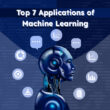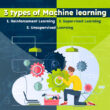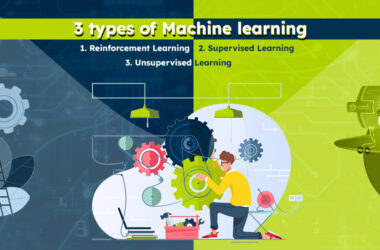Artificial intelligence (AI), machine learning (ML), and deep learning (DL) is being embraced by companies and developers worldwide in this new technological era. It is common for all of these acronyms to be used informally in the world of technology. It’s crucial to realise that these abbreviations fall under the artificial intelligence (AI) umbrella.
In machine learning, computers use algorithms to learn from data and perform tasks automatically without explicit programming. A sophisticated set of algorithms is used in deep learning to mimic the human brain. This makes it possible to process unstructured data, including text, photos, and documents.
Machine Learning:
Machine learning is an application of Artificial Intelligence (AI) that allows a system to learn from experience and improve over time. Data is used by machine learning to train and produce precise outcomes. Machine learning aims to create computer software that can access data and use it to educate itself.
Deep Learning:
Artificial neural networks and recurrent neural networks are related to deep learning, a subset of machine learning. The algorithms are developed in the same way as machine learning is done, but there are many more tiers of algorithms. The term “artificial neural network” is used to refer to all of these algorithmic network structures.
In very basic terms, it mimics how the human brain functions because all of the neural networks are interconnected, which is exactly the idea behind deep learning. With the aid of its procedures and algorithms, it is able to resolve all complicated problems.
On the basis of the following things, we can distinguish deep learning and machine learning-
Hardware-
Machine learning applications are frequently less sophisticated and can run on standard computers, whereas deep learning systems require powerful hardware and resources. Due to this power consumption, graphics processing units are becoming increasingly popular in the field. Due to thread parallelism (the ability of many operations to run efficiently simultaneously), GPUs may disguise latency in memory transfer and have high bandwidth memories.
Time-
Although machine learning systems can be set up and running quickly, their effectiveness may be limited. Despite requiring additional setup time, deep learning systems produce results immediately (although their quality is likely to improve over time as more data becomes available).
Goal-
Machine learning is applied to provide an output that is as close to the intended outcome as possible. Deep learning is used to simulate how the human brain truly thinks. The proper output will be produced automatically if machines can think in that way.
Applications-
You have probably already realised that machine learning and deep learning systems are used for various applications, given all the other differences mentioned above. Where to use them: Basic machine learning applications include email spam detectors, algorithms that create evidence-based treatment plans for patients, and predictive programs (for example, predicting the stock market’s prices or the location and timing of the next hurricane).
One widely publicised use of deep learning is in self-driving cars, which use multiple layers of neural networks to perform tasks like identifying objects to avoid, recognising traffic lights, and determining when to speed up or slow down. Other examples include Netflix, music streaming services, and facial recognition.
Human Involvement-
Whereas a human needs to define and hand-code the applied characteristics based on the data type with machine learning systems, a deep learning system seeks to learn such features without additional human interaction. Consider a facial recognition software system.
A face’s borders and lines are the first things the program learns to detect and recognise, followed by the face’s more important features and, lastly, its overall appearance.
The amount of data required to do this is immense, and as time passes and the software develops, the likelihood of getting the right answer rises. A human does not need to recode the software for this training to take place because neural networks are used, which is comparable to how the human brain functions.
Approach-
Machine learning typically uses conventional techniques like linear regression and calls for organised data. In deep learning, neural networks are used to handle enormous amounts of unstructured data.
Interpretation of result-
For a specific problem, the result is simple to interpret. Because we can simply analyse the results when using machine learning, it is clear why a particular result occurred and how the process worked.
It is extremely difficult to interpret the results for a specific problem. In some cases, we may get a better result with a deep learning model than with a machine learning model, but we are unable to explain why.
Feature Engineering-
Feature extraction by a professional is necessary before moving forward with machine learning models. Since deep learning is an improved form of machine learning, it does not require a feature extractor to be created for every issue but instead attempts to learn high-level features independent of the data.
Future of Deep Learning and Machine Learning:
Our lives will be impacted by machine learning and deep learning for centuries to come, and their capabilities will change almost every industry. Working in hazardous areas or dangerous vocations like space travel could be completely replaced by machines.
People will look to artificial intelligence at the same time to provide rich, novel entertainment experiences that seem to come straight out of science fiction.
Conclusion:
A machine is given cognitive ability using artificial intelligence. Early AI systems relied on pattern matching and expert systems when comparing AI vs machine learning. Machine learning is based on the notion that a computer can learn independently without a human’s assistance. The computer must figure out how to use the data to teach itself how to do a task.
The advancement in artificial intelligence is deep learning. Deep learning produces excellent results when there is enough data to train on, especially for text translation and image recognition. The primary explanation is that feature extraction occurs automatically at various network tiers.









